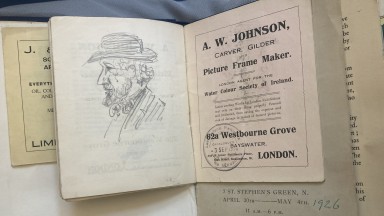This may come as a surprise to some, as all of the items within this folio receive this reference number without alluding their bound companions.
The book in question belongs to the Harry Kernoff Papers held in the NLI. We received this collection in 1975, a year after Kernoff’s death, from the artist’s sister Lena. It contains items such as newspaper cuttings and letters, as well as some of his original prints and worked woodblocks.
The catalogues from exhibitions are varied and include shows run by the South Tipperary Art Club, the Black and White Artists Society of Ireland and the Watercolour Society of Ireland. One interesting catalogue to note is that of the 1954 An Tostal: Exhibition of Contemporary Irish Art held at the International Hotel in Bray.
In the book Painting Dublin, Milligan titles her chapter on Kernoff “Radicals, Workers and Drinkers”—in which she says:
His travels around the city were made visibly evident through the drawings found among the artists papers.
Within these catalogues, Kernoff made notes in the margins regarding prices, which fellow artists had been elected to the Royal Hibernian Academy and circled his own appearances within the pages in pencil or pink ink. Some of the more interesting additions are Kernoff’s sketches, frequently on the front or back covers. They were done in plain or red pencil and showed brief views of faces or side profiles. The lines were quick and multiple.
Kernoff is known for the subject matter of his works. He captured social life through streetscapes and portraiture. His depictions were never romanticised, and he had special sympathies for the unemployed, particularly the men who waited for work at the Dublin docks. Aside from the various people of Dublin, he portrayed many people in the public eye in the mid-20th century such as W.B. Yeats, Sean O’Casey and Eamon De Valera. Kernoff himself became a sort of recognised figure in Dublin, with his small stature and black fedora, seen throughout the city. He was a frequent visitor to the Palace Bar on Fleet Street, and it is said he could be seen “scouring other Dublin pubs for suitable portrait subjects.”
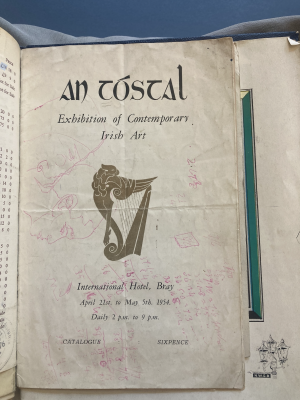
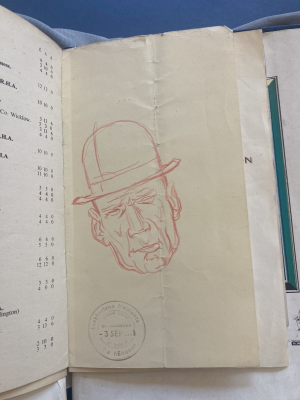
In the sketches of these exhibition catalogues, we see Kernoff on the search. When discussing his work, Kernoff wrote:
I prefer doing a portrait in one sitting, and retain the freshness of vision thereby, and avoid a laboured work.
His early work, both a self-portrait and life drawings, are described by Mulligan as having “light, graphite lines.” These traits are seen in the quick renderings within the exhibition catalogues.
These drawings are a lovely find because they remind viewers of how the artist works. The exhibition catalogues with Kernoff’s works circled in pink pen represent one of the final stages of a work of art— it has been thought through and worked over, finished, priced and displayed for the public. Yet alongside this, we also see the beginning of Kernoff’s process through his sketches taken down from the public.
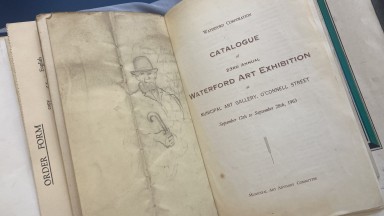
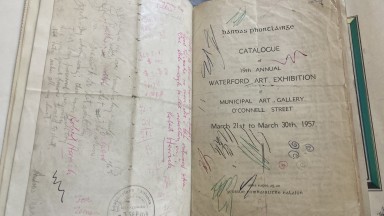
-----
Sources:
- Painting Dublin: Visualising a Changing City, 1886-1949 - Kathryn Milligan
- Harry Kernoff – Dictionary of Irish Biography
- Harry Kernoff’s Iconic Portraits – Robert O’Byrne, Irish Arts Review Vol. 24 no. 3 (2007)
